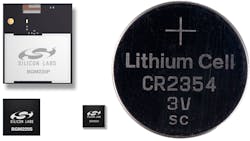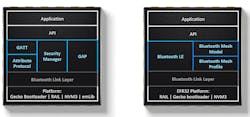Tiny Bluetooth Modules Run 10 Years on Single-Cell Battery
Silicon Labs’ BGM220 system-on-chip (SoC) packs a pair of Arm cores to manage Bluetooth communication that spans the standards from Bluetooth 4.x through 5.2 as well as Bluetooth mesh (Fig. 1). It can operate for a decade using just a single-cell CR2354 battery, providing Bluetooth communication over that span.
A dedicated Cortex-M0+ handles real-time chores and the radios, while a Cortex-M33 runs the bulk of the Bluetooth stack with plenty of headroom for applications (Fig. 2). Thanks to the modular software configuration, developers can choose which standards to utilize to optimize power, range, and throughput for their application.
The EFR32 BGM22 (BG22) chip is available separately or incorporated into two highly-integrated, pre-certified module solutions. The BG22 wireless SoC is available in three packages: 4-mm by 4-mm QFN32, 4-mm by 4-mm TQFN32 and 5-mm by 5-mm QFN 40. The 6-mm by 6-mm BGM220 system-in-package (SiP) module adds an on-board antenna and an RF pin coupled to a +6-dBm transmitter. The BGM220 SiP incorporates 25 GPIO.
The larger BGM220P is built on a 13- × 15-mm PCB and the transmitter can operate up to +8 dBm. It also has a built-in antenna and can be used with or without a built-in LFXO. The BGM220P provides more range at a low cost.
The SiPs integrate dc-dc power management plus all passives and on-board crystals. Versions are available that can handle extended temperatures up to 105°C. They’re Bluetooth 5.2 certified and address standards such as CE, FCC/ISED, MIC, and Telec.
The BGM220 has up to 512 kB of flash memory shared by both processors. There’s also up to 32 kB of RAM. Active current is 25 μA/MHz while the full 32 kB of RAM can be maintained in sleep mode for 1.4 μA. Operating voltage range is 1.71 to 3.8 V.
The radios support Bluetooth 5.2 and Bluetooth mesh LPN (low power node) as well as 1M, 2M, Bluetooth Low Energy (BLE) Coded PHY audio, and angle of arrival (AoA)/departure (AoD) for location support. Proprietary 2.4-GHz support can handle 2/4(G)FSK, (G)MSK, OQPSK, and DSSS.
Silicon Labs provides development tools in addition to the configurable protocol stacks. The Xpress option offers a pre-programmed API-driven solution that allows developers to concentrate on their application while taking advantage of wireless connectivity.
Developers can use Silicon Labs’ Simplicity Studio to tune their Bluetooth stack, depending on the features they need. For example, BLE requires only 158 kB of flash while a full-blown mesh stack runs about 300 kB. There’s also a stripped-down mesh node configuration. This enables the chip to handle chores from a high-end gateway to very low power nodes.
The company also built in Wi-Fi Packet Traffic Arbitration (PTA) coexistence support. This four-wire interface allows a host processor to manage the Bluetooth transmitters with its other wireless transmitters so that they don’t try to use the same bands at the same time. Essentially, the interface includes request to transmit, allow transmission, and a priority line.
The chip is designed for secure solutions starting with a root of trust and secure loader (RTSL). This includes secure boot support as well as secure, over-the-air updates.
Silicon Labs provides a range of evaluation and development platforms (Fig. 3), starting with a low-end node to a complete platform with interchangeable radios.
The BGM220 can act as a standalone wireless solution as well as become a wireless support device for a host. The latter is often a gateway platform, such as a Wi-Fi device that may be a Bluetooth bridge, or use Bluetooth for local wireless configuration and management.
About the Author
William G. Wong
Senior Content Director - Electronic Design and Microwaves & RF
I am Editor of Electronic Design focusing on embedded, software, and systems. As Senior Content Director, I also manage Microwaves & RF and I work with a great team of editors to provide engineers, programmers, developers and technical managers with interesting and useful articles and videos on a regular basis. Check out our free newsletters to see the latest content.
You can send press releases for new products for possible coverage on the website. I am also interested in receiving contributed articles for publishing on our website. Use our template and send to me along with a signed release form.
Check out my blog, AltEmbedded on Electronic Design, as well as his latest articles on this site that are listed below.
You can visit my social media via these links:
- AltEmbedded on Electronic Design
- Bill Wong on Facebook
- @AltEmbedded on Twitter
- Bill Wong on LinkedIn
I earned a Bachelor of Electrical Engineering at the Georgia Institute of Technology and a Masters in Computer Science from Rutgers University. I still do a bit of programming using everything from C and C++ to Rust and Ada/SPARK. I do a bit of PHP programming for Drupal websites. I have posted a few Drupal modules.
I still get a hand on software and electronic hardware. Some of this can be found on our Kit Close-Up video series. You can also see me on many of our TechXchange Talk videos. I am interested in a range of projects from robotics to artificial intelligence.




